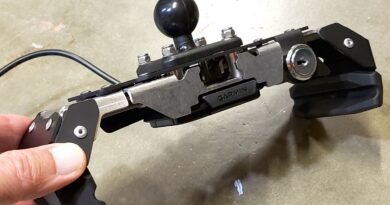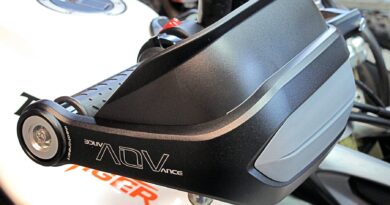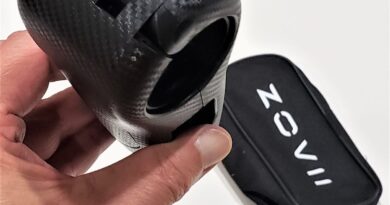Operation Buzzkill, Part 3: Rox Bar Risers
The first two articles in this series covered products that reduce a rider’s experience of handlebar vibration through extra cushioning at the grips or added weight at the bar-ends. I had hoped to feature a third type of vibration-damping mechanism here, Pivoting Anti-Vibe Bar-Risers from Minnesota-based ROX SpeedFX. These clever devices incorporate rubber bushings designed to isolate the bars from the chassis, promising a substantial reduction in vibration transmission to the grips. Unfortunately, they aren’t safe for use on my 2013 F 800 GT. Bummer.
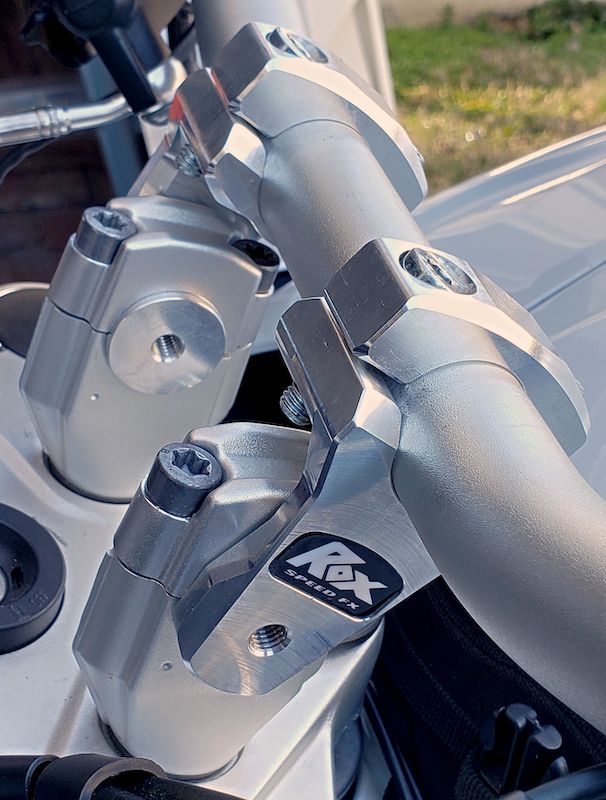
Although these risers may be an effective solution on your bike, the problem on my machine involves combining their vertical pivots (they have horizontal pivots, too) with the vertical pivots created by the GT’s single-bolt bar-clamp bases, which are not indexed to the triple-clamp. If all these pivots end up in the same orientation, the risers could rotate in relation to the triple-clamp, with each riser’s clamp orbiting its respective (now twisting) base. The handlebars would thereby move in a lateral arc across the triple-clamp; they’d remain “straight,” but displaced to the right or left. Obviously, this would be quite perilous during a ride! The likelihood of such shifting decreases with divergence of the riser’s vertical pivots from alignment with the mount pivots (e.g., as the risers move rearward on their horizontal pivots), but ROX understandably recommends against fitment of this product on bikes with similar OEM bar-clamp mounting arrangements.
All was not lost. ROX makes other bar-risers not meant to address vibration directly. These include adjustable versions that pivot fore and aft like the ones I’d hoped to use, and others that locate the bar in a fixed position higher and/or further back (or, when reversed, further forward) than the stock setup. These adjustable risers come in multiple heights ranging from 1.75 to 5 inches, and allow mounting the bars along a fore/aft vertical arc defined by the risers as they rotate – temporarily during installation! – on their horizontal pivots within the original bar-clamps.
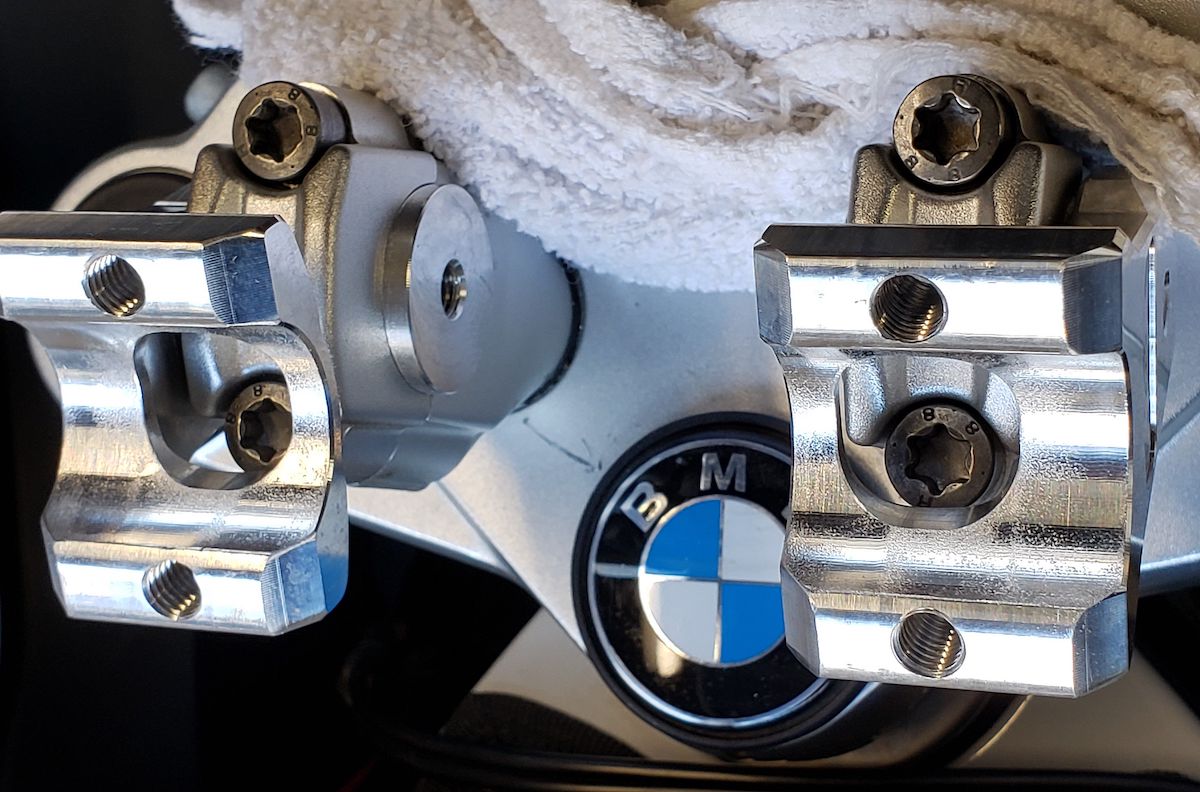
The non-adjustable risers, also available in several sizes, either simply extend inline with the existing bar-clamp bases or relocate the bars about 35 degrees from the bases’ longitudinal axes, combining increased height with this fore/aft change. Virtually all ROX risers come in versions for 7/8” or 1-1/8” bars, and some fit either size using shims, allowing conversion to a non-OEM bar diameter. (Also, a special raised base is available for the cast handlebars on some BMW models, and there are dedicated risers for the 1-1/4” bars on 2013 and later R 1200 and 1250 GS models.) All are made in the USA from machined billet 6061-T6 aircraft-grade aluminum, and most come in several finishes.
I said “not meant to address vibration directly” earlier because even non-rubber-bushing-equipped risers can reduce the negative effects of vibration by decreasing the amount of weight on a rider’s hands. Less pressure equals less intense physical engagement with the buzzing grips, and therefore less numbness, tingling and fatigue, yielding increased comfort and safety. The neutral ergonomics of a more upright riding position may also benefit wrists, elbows, shoulders, lower back, and hips, compounding the advantages at the grip-hand interface.
If you want to precisely customize your setup, the pivoting risers may be best. However, they could also necessitate changes to your hand controls’ cables and hoses, which may no longer reach their intended targets, or do so only with dangerous strain. If you don’t want to swap out or modify parts, fixed risers may be preferable, as they tend to move the bars less distance from their original location and might not require extra parts and labor. See the fitment chart on ROX’s website to determine whether your application will need such extra mods.
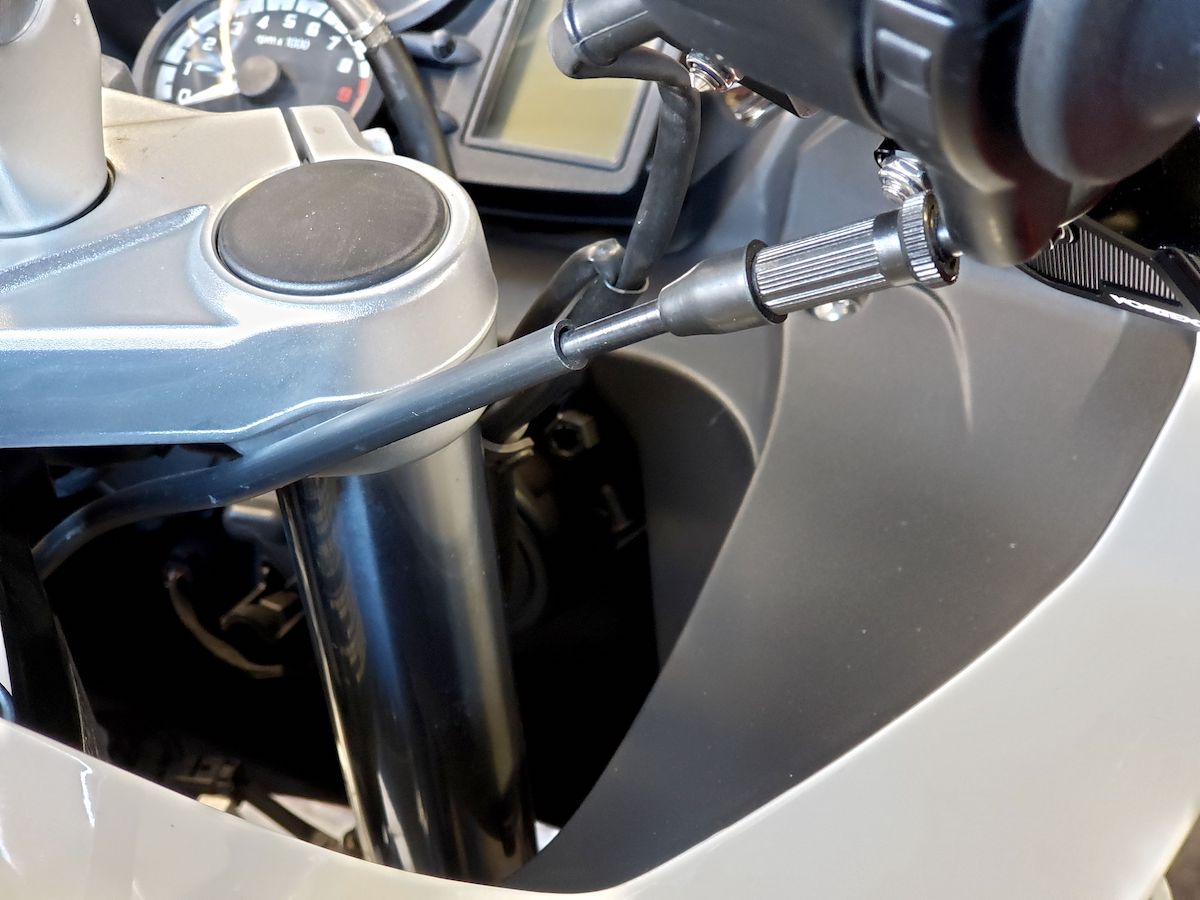
I tried both riser types on the F 800 GT. The 2” adjustable model (acquired first) did indeed demand a longer brake line, accomplished temporarily with an unsightly extension using a scrap part. This avoided the expense of a full line replacement and didn’t require bleeding the whole system before assessing the bar relocation. The throttle cable had to be rerouted from in front of the right fork leg to behind it. On this bike, doing so created no problems, but it might on other models – be extremely careful to check any such modification, as a malfunctioning throttle could result in loss of control and severe injury or death. After trying several angles, I settled on roughly 30 degrees back and found this a nice compromise between maximizing height and maximizing rearward translation. It was more comfortable on long rides than the sportier stock arrangement for all the ergonomic reasons listed above, and I enjoyed a subtle reduction in vibration-induced ills.
I liked ROX’s 1-1/2” fixed Barback risers even better. They moved the bar 1” back and 1-1/2” up, preserving a tad more of the sport in my bike’s sport-touring mission, and delivered as much benefit for me as the pivoting version in a more elegant package. Full disclosure: I’m on the short side at 5’8”, with average proportions. Riders with different bodily measurements may need different riser dimensions to achieve similar results.
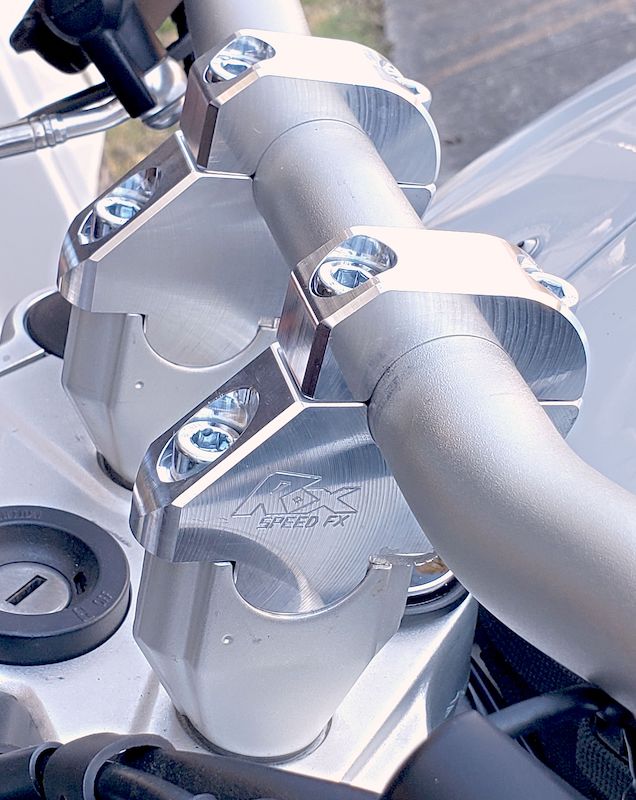
Sadly, the F 800 GT’s stingy OEM brake line allowance just barely failed to reach the master cylinder with the fixed risers installed – soooo close and yet so far! Unwilling to abide my ugly extension beyond the duration of this evaluation, I bit the bullet and bought a beautifully crafted, albeit exorbitantly priced ($65 including shipping), aluminum adapter made by German fabricator Voigt Moto Technik and sourced in the US through HeliBars. It unobtrusively relocates the master cylinder’s line junction 18 mm lower and 20 mm forward, and it needn’t be removed if I want to return my bars to their original location for a sportier outing. As a bonus, it adds a tiny bleed screw to the system. Note this piece is described as providing a 30-millimeter difference, which is correct if measured on the diagonal.
Aside from dealing with any required cable or hose length issues, installation of the adjustable risers is simple and straightforward. Just pop off the existing bar-clamp caps and remove the handlebar. Lay it on a towel spread over the closest supporting surface, or get creative and suspend it from your garage rafters with bungee cords. Replace those caps with the risers’ posts resting in the cradles where the bar had been. Note the risers have a limited range allowing access to the clamp bolts through the risers’ “windows.” With the risers at your desired angle, tighten the clamp bolts to the torque values specified in your bike’s manual, making sure they are both at EXACTLY the same angle or your handlebar will be cocked when you finish up. If your bases are mounted with single bolts and not indexed to the triple clamp, you may have to hold them still with flat-jawed pliers while torquing.
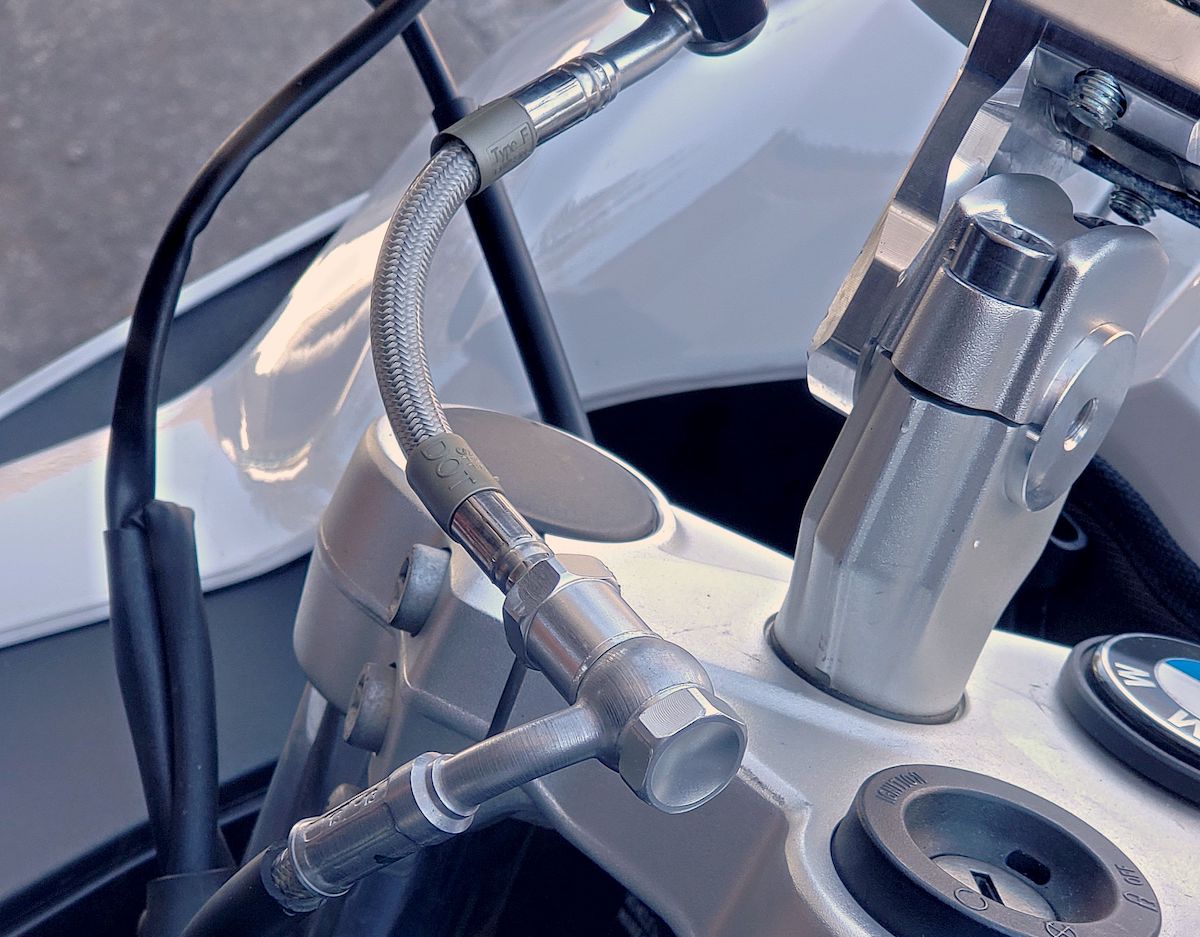
Now rest the bars in the riser cradles and rotate them to your preferred orientation, keeping them centered. Lay the riser caps over the bar and torque them to spec. Test the bars at full lock in both directions to ensure they don’t pinch your digits against tank or fairing. Have the motor running to see if there’s any change in rpm indicating a stretched or binding throttle cable, then turn the motor off and check for smooth throttle operation throughout the twistgrip’s rotation at both handlebar extremes. Check for proper clutch and brake operation, too. Ride and repeat the above to make any adjustments.
The fixed risers are even easier to install. Simply remove the handlebars, bolt the lower portions of the risers in place where the original clamp caps were, rest the handlebar in the riser cradles, and secure them with the riser caps. Use proper torque and perform the same checks as described above. Installing either the adjustable or the fixed risers is a sub-40-minute operation, not counting cable and hose mods. ROX includes all necessary mounting hardware: eight Class 8.8 10mm hex key bolts for the fixed kit, and four of the same for the adjustable one. The fixed risers also come with two shims to fill the gaps left under the trailing edges in offset base cradles, like those on my bike.
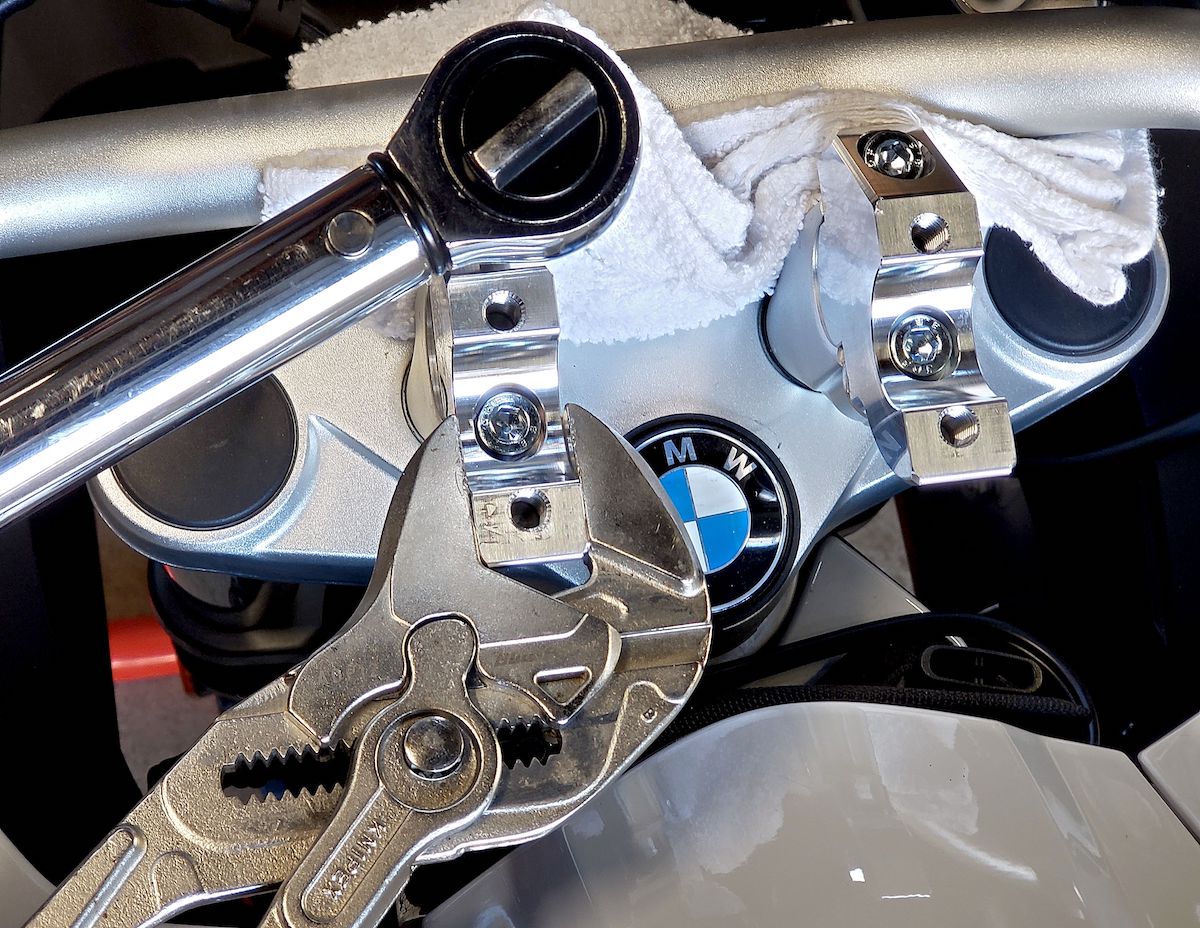
If the only benefit of these bar risers was their small reduction of vibration effects, it might be hard to justify their costs: $98.95-101.95 for the 2” pivoting risers (depending on selected finish) and $119.95 for the 1.5” fixed risers. Given their considerable ergonomic advantages, though, I consider either of them a good investment, even if their impact on vibration-related discomfort is a minor side effect. ROX offers a 60-day return policy for customers who buy directly from them, and shipping is free on orders over $50; there’s a $10 restocking fee and no allowance for return shipping costs, except in the case of incorrect or defective items.
At $171.95, the originally sought Pivoting Anti-Vibe Risers could be an excellent value if they work as advertised, combining the benefits listed above with even greater reduction in vibration. If you’ve tried them, please let us know how they performed.
Check back for the final episode in this series, wherein I’ll try one last fix for the F 800 GT’s only real flaw: Spider Grips and aftermarket grip heaters.

